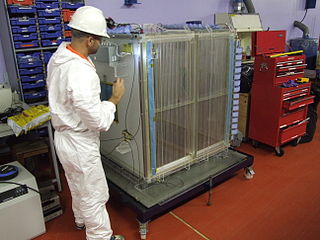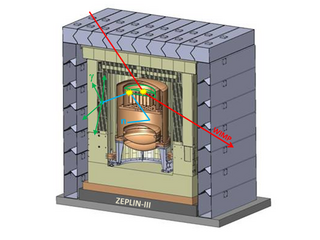Related Research Articles
Weakly interacting massive particles (WIMPs) are hypothetical particles that are one of the proposed candidates for dark matter.

A bubble chamber is a vessel filled with a superheated transparent liquid used to detect electrically charged particles moving through it. It was invented in 1952 by Donald A. Glaser, for which he was awarded the 1960 Nobel Prize in Physics. Supposedly, Glaser was inspired by the bubbles in a glass of beer; however, in a 2006 talk, he refuted this story, although saying that while beer was not the inspiration for the bubble chamber, he did experiments using beer to fill early prototypes.
The Cryogenic Dark Matter Search (CDMS) is a series of experiments designed to directly detect particle dark matter in the form of Weakly Interacting Massive Particles. Using an array of semiconductor detectors at millikelvin temperatures, CDMS has at times set the most sensitive limits on the interactions of WIMP dark matter with terrestrial materials. The first experiment, CDMS I, was run in a tunnel under the Stanford University campus. It was followed by CDMS II experiment in the Soudan Mine. The most recent experiment, SuperCDMS, was located deep underground in the Soudan Mine in northern Minnesota and collected data from 2011 through 2015. The series of experiments continues with SuperCDMS SNOLAB, an experiment located at the SNOLAB facility near Sudbury, Ontario in Canada that started construction in 2018 and is expected to start data taking in early 2020s.
The XENON dark matter research project, operated at the Italian Gran Sasso National Laboratory, is a deep underground detector facility featuring increasingly ambitious experiments aiming to detect hypothetical dark matter particles. The experiments aim to detect particles in the form of weakly interacting massive particles (WIMPs) by looking for rare nuclear recoil interactions in a liquid xenon target chamber. The current detector consists of a dual phase time projection chamber (TPC).

The UK Dark Matter Collaboration (UKDMC) (1987–2007) was an experiment to search for Weakly interacting massive particles (WIMPs). The consortium consisted of astrophysicists and particle physicists from the United Kingdom, who conducted experiments with the ultimate goal of detecting rare scattering events which would occur if galactic dark matter consists largely of a new heavy neutral particle. Detectors were set up 1,100 m (3,600 ft) underground in a halite seam at the Boulby Mine in North Yorkshire.

SNOLAB is a Canadian underground science laboratory specializing in neutrino and dark matter physics. Located 2 km below the surface in Vale's Creighton nickel mine near Sudbury, Ontario, SNOLAB is an expansion of the existing facilities constructed for the original Sudbury Neutrino Observatory (SNO) solar neutrino experiment.
The ArDM Experiment was a particle physics experiment based on a liquid argon detector, aiming at measuring signals from WIMPs, which may constitute the Dark Matter in the universe. Elastic scattering of WIMPs from argon nuclei is measurable by observing free electrons from ionization and photons from scintillation, which are produced by the recoiling nucleus interacting with neighbouring atoms. The ionization and scintillation signals can be measured with dedicated readout techniques, which constituted a fundamental part of the detector.

DEAP is a direct dark matter search experiment which uses liquid argon as a target material. DEAP utilizes background discrimination based on the characteristic scintillation pulse-shape of argon. A first-generation detector (DEAP-1) with a 7 kg target mass was operated at Queen's University to test the performance of pulse-shape discrimination at low recoil energies in liquid argon. DEAP-1 was then moved to SNOLAB, 2 km below Earth's surface, in October 2007 and collected data into 2011.

The Large Underground Xenon experiment (LUX) aimed to directly detect weakly interacting massive particle (WIMP) dark matter interactions with ordinary matter on Earth. Despite the wealth of (gravitational) evidence supporting the existence of non-baryonic dark matter in the Universe, dark matter particles in our galaxy have never been directly detected in an experiment. LUX utilized a 370 kg liquid xenon detection mass in a time-projection chamber (TPC) to identify individual particle interactions, searching for faint dark matter interactions with unprecedented sensitivity.

The Directional Recoil Identification from Tracks (DRIFT) detector is a low pressure negative ion time projection chamber (NITPC) designed to detect weakly interacting massive particles (WIMPs) - a prime dark matter candidate.

The European Underground Rare Event Calorimeter Array (EURECA) is a planned dark matter search experiment using cryogenic detectors and an absorber mass of up to 1 tonne. The project will be built in the Modane Underground Laboratory and will bring together researchers working on the CRESST and EDELWEISS experiments.

EDELWEISS is a dark matter search experiment located at the Modane Underground Laboratory in France. The experiment uses cryogenic detectors, measuring both the phonon and ionization signals produced by particle interactions in germanium crystals. This technique allows nuclear recoils events to be distinguished from electron recoil events.
The Dark Matter Time Projection Chamber (DMTPC) is an experiment for direct detection of weakly interacting massive particles (WIMPs), one of the most favored candidates for dark matter. The experiment uses a low-pressure time projection chamber in order to extract the original direction of potential dark matter events. The collaboration includes physicists from the Massachusetts Institute of Technology (MIT), Boston University (BU), Brandeis University, and Royal Holloway University of London. Several prototype detectors have been built and tested in laboratories at MIT and BU. The collaboration took its first data in an underground laboratory at the Waste Isolation Pilot Plant (WIPP) site near Carlsbad, New Mexico in Fall, 2010.
SIMPLE is an experiment search for direct evidence of dark matter. It is located in a 61 m3 cavern at the 500 level of the Laboratoire Souterrain à Bas Bruit near Apt in southern France. The experiment is predominantly sensitive to spin-dependent interactions of weakly interacting massive particles.

The ZEPLIN-III dark matter experiment attempted to detect galactic WIMPs using a 12 kg liquid xenon target. It operated from 2006 to 2011 at the Boulby Underground Laboratory in Loftus, North Yorkshire. This was the last in a series of xenon-based experiments in the ZEPLIN programme pursued originally by the UK Dark Matter Collaboration (UKDMC). The ZEPLIN-III project was led by Imperial College London and also included the Rutherford Appleton Laboratory and the University of Edinburgh in the UK, as well as LIP-Coimbra in Portugal and ITEP-Moscow in Russia. It ruled out cross-sections for elastic scattering of WIMPs off nucleons above 3.9 × 10−8 pb from the two science runs conducted at Boulby.
The Particle and Astrophysical Xenon Detector, or PandaX, is a dark matter detection experiment at China Jinping Underground Laboratory (CJPL) in Sichuan, China. The experiment occupies the deepest underground laboratory in the world, and is among the largest of its kind.
The Cryogenic Low-Energy Astrophysics with Noble liquids (CLEAN) experiment by the DEAP/CLEAN collaboration is searching for dark matter using noble gases at the SNOLAB underground facility. CLEAN has studied neon and argon in the MicroCLEAN prototype, and running the MiniCLEAN detector to test a multi-ton design.

The LUX-ZEPLIN (LZ) Experiment is a next-generation dark matter direct detection experiment hoping to observe weakly interacting massive particles (WIMP) scatters on nuclei. It was formed in 2012 by combining the LUX and ZEPLIN groups. It is currently a collaboration of 30 institutes in the US, UK, Portugal and South Korea. The experiment is located at the Sanford Underground Research Facility (SURF) in South Dakota, and is managed by DOE's Lawrence Berkeley National Lab.

Jocelyn Monroe is an American experimental particle physicist who is a professor at Royal Holloway, University of London. Her research considers the development of novel detectors as part of the search for dark matter. In 2016 she was honoured with the Breakthrough Prize in Fundamental Physics for her work on the Sudbury Neutrino Observatory.
Direct detection of dark matter is the science of attempting to directly measure dark matter collisions in Earth-based experiments. Modern astrophysical measurements, such as from the Cosmic Microwave Background, strongly indicate that 85% of the matter content of the universe is unaccounted for. Although the existence of dark matter is widely believed, what form it takes or its precise properties has never been determined. There are three main avenues of research to detect dark matter: attempts to make dark matter in accelerators, indirect detection of dark matter annihilation, and direct detection of dark matter in terrestrial labs. The founding principle of direct dark matter detection is that since dark matter is known to exist in the local universe, as the Earth, Solar System, and the Milky Way Galaxy carve out a path through the universe they must intercept dark matter, regardless of what form it takes.
References
- ↑ "PICO". SNOLAB. Retrieved 2015-12-01.
- ↑ "PICO/PICASSO". Institute of Particle Physics. Retrieved 2015-12-02.
The PICASSO and COUPP collaborations merged in 2013 to form the PICO collaboration.
- ↑ "Bubble detector". Archived from the original on 2008-03-20. Retrieved 2008-12-23.
- ↑ "Inspire".
- ↑ S. Archambault; et al. (PICASSO Collaboration) (2009). "Dark matter spin-dependent limits for WIMP interactions on 19F by PICASSO". Physics Letters B . 682 (2): 185–92. arXiv: 0907.0307 . Bibcode:2009PhLB..682..185A. doi:10.1016/j.physletb.2009.11.019. S2CID 15163629.
- ↑ PICASSO Collaboration (3 May 2012). "Constraints on low-mass WIMP interactions on 19F from PICASSO". Physics Letters B. 711 (2): 153–161. arXiv: 1202.1240 . Bibcode:2012PhLB..711..153A. doi:10.1016/j.physletb.2012.03.078. S2CID 4285716.
- ↑ "PICO dark matter search experiment".
- ↑ "PICO-40L – PICO Experiment" . Retrieved 2022-02-22.
- ↑ "PICO-500 – PICO Experiment" . Retrieved 2022-02-22.
